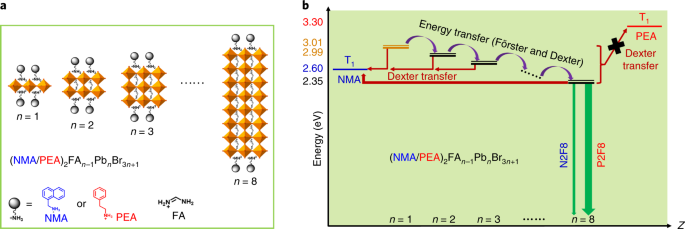
Triplet management for efficient perovskite light-emitting diodes
- Select a language for the TTS:
- UK English Female
- UK English Male
- US English Female
- US English Male
- Australian Female
- Australian Male
- Language selected: (auto detect) - EN
Play all audios:
Perovskite light-emitting diodes are promising for next-generation lighting and displays because of their high colour purity and performance1. Although the management of singlet and triplet
excitons is fundamental to the design of efficient organic light-emitting diodes, the nature of how excitons affect performance is still not clear in perovskite2,3,4 and
quasi-two-dimensional (2D) perovskite-based devices5,6,7,8,9. Here, we show that triplet excitons are key to efficient emission in green quasi-2D perovskite devices and that quenching of
triplets by the organic cation is a major loss path. Employing an organic cation with a high triplet energy level (phenylethylammonium) in a quasi-2D perovskite based on formamidinium lead
bromide yields efficient harvesting of triplets. Furthermore, we show that upconversion of triplets to singlets can occur, making 100% harvesting of electrically generated excitons
potentially possible. The external quantum and current efficiencies of our green (527 nm) devices reached 12.4% and 52.1 cd A−1, respectively.
The data that support the plots within this paper and other findings of this study are available from the corresponding author upon reasonable request.
This work was supported by the Japan Science and Technology Agency (JST), ERATO, Adachi Molecular Exciton Engineering Project under JST ERATO grant no. JPMJER1305, Japan, and the
International Institute for Carbon Neutral Energy Research (WPI-I2CNER) sponsored by the Ministry of Education, Culture, Sports, Science and Technology (MEXT), and The Canon Foundation. C.Q.
acknowledges support from funding by the Changchun Institute of Applied Chemistry (CIAC). We thank Pohang Accelerator Laboratory (PAL) for giving us the opportunity to perform the GIWAXS
measurements and MEST and POSTECH for supporting these experiments, H. Ahn for adjustments and help, and other colleagues from the 9A USAXS beamline for assistance. Part of this work at
Kyoto was supported by JST-CREST (grant no. JPMJCR16N3). This research was supported in part by the CNRS (PICS N8 8085), France.
Center for Organic Photonics and Electronics Research (OPERA), c/o Japan Science and Technology Agency (JST), ERATO, Adachi Molecular Exciton Engineering Project, Kyushu University, Fukuoka,
Japan
Chuanjiang Qin, Toshinori Matsushima, William J. Potscavage Jr, Atula S. D. Sandanayaka, Matthew R. Leyden, Fatima Bencheikh, Kenichi Goushi & Chihaya Adachi
State Key Laboratory of Polymer Physics and Chemistry, Changchun Institute of Applied Chemistry (CIAC), Chinese Academy of Sciences, Changchun, China
International Institute for Carbon-Neutral Energy Research (WPI-I2CNER), Kyushu University, Fukuoka, Japan
Sorbonne Université, Institut Parisien de Chimie Moléculaire, UMR 8232, Chimie des Polymères, Paris, France
Institut de Physique et Chimie des Matériaux de Strasbourg, UMR 7504, CNRS – Université de Strasbourg, Strasbourg, France
Institute for Chemical Research, Kyoto University, Kyoto, Japan
Innovative Organic Device Laboratory, Institute of Systems, Information Technologies and Nano-technologies (ISIT), Fukuoka, Japan
Fukuoka i3-Center for Organic Photonics and Electronics Research (i3-OPERA), Fukuoka, Japan
C.Q. and C.A. conceived the concept. C.Q. designed all experiments and fabricated devices. C.Q. and T.M. performed the optical absorption, electroluminescence measurements and device
characterization. F.M., B.H. and C.Q. performed GIWAX and XRD analysis. C.Q. and K.G. measured temperature-dependent transient photoluminescence. C.Q., G.Y., K.G. and Y.K. performed
transient absorption measurement and analysis. F.B. performed the simulations. C.Q., W.J.P., M.R.L. and A.S.D.S. performed data analysis and figure preparation. C.Q. wrote the draft. All
authors discussed the results and commented on the manuscript. C.A. supervised the project.
Publisher’s note Springer Nature remains neutral with regard to jurisdictional claims in published maps and institutional affiliations.
Energy transfer mechanisms, photoluminescence data and external quantum efficiency statistics.
Anyone you share the following link with will be able to read this content: